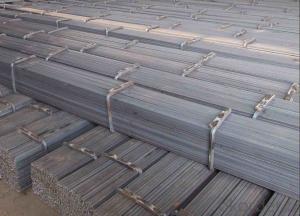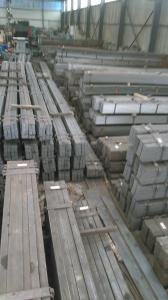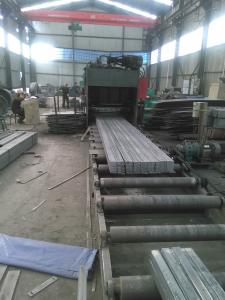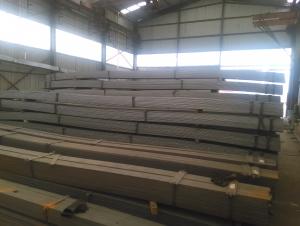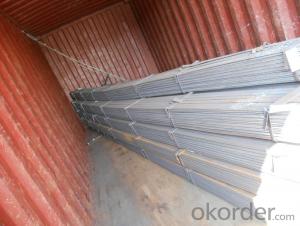high quality flat bar GB Q235 or wide falt bar
- Loading Port:
- Tianjin
- Payment Terms:
- TT OR LC
- Min Order Qty:
- 25 m.t.
- Supply Capability:
- 20000 m.t./month
OKorder Service Pledge
OKorder Financial Service
You Might Also Like
lat bar Details:
| Minimum Order Quantity: | Unit: | m.t. | Loading Port: | ||
| Supply Ability: | 10000 | Payment Terms: | Package: | Steel Packing |
Product Description:
Product Description:
Specification of Mild Steel Flat Bar
Commodity: Mild Steel Flat Bar
Standard: GB;JIS
Material: Q195-235;SS400
Brand name: FLATSPACE
Origin place: China
Thickness: 3mm-30mm
Width:20mm-200mm
Length: Max 12m
Certification: SGS/BV
Chemical composition of Q235
Alloy No | Grade | Element(%) | ||||
C | Mn | S | P | Si | ||
Q235 | B | 0.12—0.20 | 0.3—0.7 | ≤0.045 | ≤0.045 | ≤0.3 |
Physical properties of Q235
Alloy No | Grade | Yielding strength point(Mpa) | Tensile strength (Mpa) | Elongation after fracture(%) | ||||||
Thickness (mm) | Thickness (mm) | |||||||||
≤16 | >16--40 | >40--60 | >60--100 | ≤16 | >16--40 | >40--60 | >60--100 | |||
≥ | ≥ | |||||||||
Q235 | B | 235 | 225 | 215 | 205 | 375--500 | 26 | 25 | 24 | 23 |
Usage/Applications of Mild Steel Flat Bar
Widely used for construction, Machinery manufacturing, Iron tower steel structure, Shipbuilding; Steel grating, Staircase, Bridge, Viaduct, Railway spare parts, Boilers making etc.
Packaging & Delivery of Mild Steel Flat Bar
Packaging Details: The Mild Steel Flat Bars are packed in bundles and loaded in 20 feet/40 feet container, or shipped by bulk cargo ,also we can do as customer's requirements.
Delivery Details:30~45 days upon the receipt of buyer payment by T.T. or L/C.
Production Flow of Mild Steel Flat Bar
The Mild steel flat bar is made through three processes:
1.Feeding the material: Feeding the row material (the steel plate) to Slitting Line.
2.Slitting:The steel plate would be slitted into expected width by lengthways cutter.
3. Leveled and cutting: The plat bar would be ground into level by the grinder and then cut into required length
- Q:What is the difference between 60X6 and 50X4 flat steel in grounding?
- The contact resistance varies with the return current.
- Q:Friction coefficient of steel pipe and flat steel on roller table!
- Flat, refers to the width 12-300mm, thickness 4-60mm, cross section is rectangular in shape and with a blunt edge of steel. Flat steel can be finished steel, or can be used as the blank of welded pipe and thin slab for laminated sheet rolling. Main application: flat steel is used as a material, used for making iron, tools and machinery parts, and used as frame structures and escalators for buildings.
- Q:What are the different methods of surface coloring or tinting for steel flat bars?
- There are multiple techniques available for coloring or tinting steel flat bars, each offering its own benefits. These methods can enhance the steel's appearance, protect against corrosion, or achieve both objectives. Some commonly used techniques include: 1. Painting: Painting is widely employed to add color to steel flat bars. It involves applying a layer of paint in the desired shade. This method not only provides color but also safeguards the steel against rust and corrosion. 2. Powder coating: Another popular method is powder coating, which entails applying a dry powder onto the steel surface. The powder is electrically charged and adheres to the steel, resulting in a durable and visually appealing coating. Powder coating offers a wide range of color options and exhibits excellent resistance to chipping, scratching, and fading. 3. Anodizing: Anodizing is typically used to color aluminum, but it can also be utilized for steel. This method involves forming a protective oxide layer on the steel's surface through an electrolytic process. The oxide layer can be dyed, resulting in a vibrant and long-lasting finish. 4. Galvanizing: Galvanizing primarily serves as a corrosion protection method, but it also imparts a silver-gray appearance to steel flat bars. This technique involves applying a layer of zinc to the steel through hot-dip or electroplating processes. Galvanized steel is highly durable and resistant to rust. 5. Chemical coloring: Chemical coloring involves treating the steel with various chemical solutions to achieve different colors. This technique can produce unique and decorative finishes, such as black oxide, bronze, or iridescent coatings. The colors obtained through chemical coloring are typically permanent and do not compromise the steel's structural integrity. 6. Patination: Patination refers to the natural aging process that occurs on steel surfaces over time, resulting in distinct colors and textures. However, this process can be accelerated by using chemicals or exposing the steel to specific environmental conditions. Patination can create varying shades of brown, green, or blue, giving steel flat bars a distinctive and weathered appearance. It is important to consider factors such as desired aesthetics, durability requirements, and intended applications when choosing a coloring method for steel flat bars.
- Q:Are steel flat bars suitable for aerospace applications?
- Indeed, steel flat bars prove to be a fitting choice for aerospace applications. In the aerospace industry, steel stands as a frequently employed material owing to its exceptional strength, durability, and mechanical properties. By utilizing steel flat bars, one can avail of a versatile and economical solution for diverse aerospace components and structures. These bars can be effectively employed in fabricating aircraft frames, wings, landing gears, and other pivotal parts that necessitate formidable strength and rigidity. Furthermore, steel flat bars can be conveniently machined, welded, and shaped into various dimensions and configurations, rendering them a suitable option for an extensive array of aerospace applications.
- Q:Can steel flat bars be hardened or heat treated?
- Yes, steel flat bars can be hardened or heat treated, depending on the specific type of steel used. Heat treatment involves heating the steel to a specific temperature and then cooling it rapidly to achieve the desired level of hardness. This process can be used to increase the strength and durability of the steel flat bars. Hardening and heat treatment are commonly employed in various industries, such as construction, manufacturing, and automotive, to enhance the properties of steel flat bars and make them suitable for specific applications.
- Q:How do steel flat bars contribute to the overall safety of a structure?
- The overall safety of a structure is greatly enhanced by steel flat bars in various ways. To begin with, they effectively distribute and transfer loads, ensuring the integrity and stability of the structure. Furthermore, their strength and durability enable them to withstand heavy loads without deforming or failing. Moreover, steel flat bars offer resistance against environmental factors that can jeopardize the safety of a structure. They are highly resistant to fire, corrosion, and extreme weather conditions, making them a reliable choice for enhancing the longevity and safety of buildings. Additionally, steel flat bars are commonly utilized in the construction of safety barriers, handrails, and guardrails. These components are essential for preventing accidents and falls, particularly in elevated areas or walkways. Steel flat bars provide a solid and secure barrier, guaranteeing the safety of individuals within the structure. Furthermore, steel flat bars are frequently employed in seismic-resistant designs. Their high strength and flexibility allow them to absorb and dissipate the energy generated during earthquakes or other seismic events. This characteristic significantly reduces the risk of collapse or structural damage during such incidents, thereby enhancing the overall safety of the structure. In conclusion, steel flat bars play a crucial role in ensuring the overall safety of structures. Their strength, durability, resistance to environmental factors, and ability to provide structural stability make them an indispensable component in the construction industry. Whether it is in supporting loads, constructing safety barriers, or enhancing seismic resistance, steel flat bars contribute significantly to the safety and longevity of structures.
- Q:How do steel flat bars contribute to the overall versatility of structures?
- Steel flat bars contribute to the overall versatility of structures by providing strong support and stability. They can be easily cut, shaped, and welded, making them adaptable to various construction projects. Additionally, their flat shape allows for efficient distribution of weight and load-bearing capacity, ensuring structural integrity. Whether used as beams, braces, or connectors, steel flat bars enhance the flexibility and durability of structures.
- Q:Are steel flat bars available in different shapes, such as round or square?
- No, steel flat bars are not available in round or square shapes. They are specifically designed with a rectangular cross-section, characterized by a long width and a relatively small thickness.
- Q:Can steel flat bars be used for making brackets or supports for power generation equipment?
- Yes, steel flat bars can be used for making brackets or supports for power generation equipment. Steel is a strong and durable material that can provide the necessary stability and strength required for supporting heavy equipment. Additionally, steel flat bars can be easily shaped, welded, and customized to fit specific design requirements, making them suitable for constructing brackets and supports in power generation applications.
- Q:What are the different types of surface patterns available for steel flat bars?
- Steel flat bars come in various surface patterns, each with its own unique qualities and advantages. Some commonly used patterns include: 1. Smooth surface: This is the most basic and widely used pattern for steel flat bars. It has a plain and flat surface without any visible textures or patterns. A smooth surface is preferred when functionality is the main focus and appearance is not a priority. 2. Serrated surface: Serrated patterns feature small grooves or ridges along the length of the steel flat bar. This pattern provides enhanced grip and traction, making it suitable for applications where slip resistance is crucial, such as walkways, ramps, or stair treads. 3. Checker plate pattern: Also known as diamond plate or tread plate pattern, it features a raised diamond-shaped pattern on the surface. This pattern offers excellent slip resistance and is commonly used in industrial settings, loading docks, truck beds, or flooring applications. 4. Hammered pattern: Hammered patterns have a textured appearance resembling the marks left by a hammer. This pattern adds aesthetic appeal to the steel flat bar and is often used in decorative applications, such as architectural detailing or furniture. 5. Galvanized surface: Galvanization is a process where steel is coated with a layer of zinc to protect it from corrosion. Galvanized steel flat bars have a shiny and smooth surface, providing excellent corrosion resistance and durability. This pattern is commonly used in outdoor applications or areas prone to moisture exposure. 6. Painted or powder-coated surface: Steel flat bars can also be painted or powder-coated to achieve a specific color or finish. This pattern allows for customization and can be used to match the surrounding environment or for aesthetic purposes. When selecting the appropriate surface pattern for a steel flat bar, it is important to consider the intended use and requirements. Each pattern offers distinct advantages, and choosing the right one can ensure optimal performance and longevity in the intended application.
1. Manufacturer Overview |
|
|---|---|
| Location | |
| Year Established | |
| Annual Output Value | |
| Main Markets | |
| Company Certifications | |
2. Manufacturer Certificates |
|
|---|---|
| a) Certification Name | |
| Range | |
| Reference | |
| Validity Period | |
3. Manufacturer Capability |
|
|---|---|
| a)Trade Capacity | |
| Nearest Port | |
| Export Percentage | |
| No.of Employees in Trade Department | |
| Language Spoken: | |
| b)Factory Information | |
| Factory Size: | |
| No. of Production Lines | |
| Contract Manufacturing | |
| Product Price Range | |
Send your message to us
high quality flat bar GB Q235 or wide falt bar
- Loading Port:
- Tianjin
- Payment Terms:
- TT OR LC
- Min Order Qty:
- 25 m.t.
- Supply Capability:
- 20000 m.t./month
OKorder Service Pledge
OKorder Financial Service
Similar products
New products
Hot products
Related keywords
